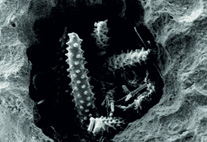Abstract
An abundant and diversified assemblage of siliceous loose sponge spicules has been identified in the Late Eocene deposits cropping out along the southern coasts of Australia. Based on the comparison of the obtained spicules with those of living sponges, representatives of at least 43 species within 33 genera, 26 families, and 9 orders of “soft” Demospongiae and Homoscleromorpha have been identified in the assemblage. Within the studied sediments, the spicules representing demosponge orders Poecilosclerida, Hadromerida, and Astrophorida were the most diverse. The rest of the five demosponge orders (Halichondrida, Agelasida, Haplosclerida, Spirophorida, and Chondrosida) are represented by single families. Also, a single family Plakinidae within the class Homoscleromorpha that includes two genera was present. The diversity of spicules is similar in all studied samples and areas, even distant geographically, and there are only minor differences between the sections. That indicates a homogenous character of this rich siliceous sponge assemblage. Most of the studied sponge spicules have Recent equivalents among present-day siliceous spicules. However, the fossil ones are bigger which is most likely due to different environmental conditions. Among the recognized sponge species, at least eleven (Agelas cf. axifera, Agelas cf. wiedenmayeri, Penares sclerobesa, Histodermella australis, Trikentrion flabelliforme, Cliona cf. mucronata, Tethya cf. omanensis, Terpios sp., Placinolopha cf. sarai, Dotona pulchella, and Sigmosceptrella quadrilobata) are noted for the first time in the fossil record.

